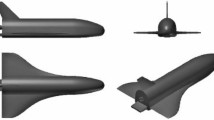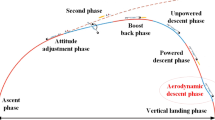Abstract
In this work, a novel strategy for the inverse optimal control of a class of affine nonlinear systems is proposed. The proposed strategy involves translation of the infinite horizon nonlinear optimal control problem into a Diagonal stability problem, followed by the formulation of a set of criteria for the synthesis of a stabilizing feedback control law. Hence, the proposed controller design methodology is refered to as inverse optimal control via diagonal stabilization. Besides providing a closed-form solution, the methodology also possesses the added advantage of inherent robustness, on account of adequate stability margins. Most importantly, the methodology ensures an estimate of the associated domain of attraction, which is a highly desirable feature especially in the case of crucial and stringent aerospace applications. The proposed methodology is applied for the re-entry control of a reusable launch vehicle which provides a full envelope optimality-based design philosophy. For this, the control-oriented attitude model based on the three-degree-of-freedom dynamic model is utilized. The resulting control law possess desirable features of guaranteed estimate of stability domain, assured design flexibility, and inherent robustness. Simulation results verify the validity of these theoretically proven facets in terms of the efficacy and robustness of the proposed controller.













Similar content being viewed by others
References
Banks, H.T., Lewis, B.M., Tran, H.T.: Nonlinear feedback controllers and compensators: a state-dependent Riccati equation approach. Comput. Optim. Appl. 37(2), 177–218 (2007)
Batmani, Y., Davoodi, M., Meskin, N.: Nonlinear suboptimal tracking controller design using state-dependent Riccati equation technique. IEEE Trans. Control Syst. Technol. 25(5), 1833–1839 (2017)
Beikzadeh, H., Taghirad, H.D.: Robust SDRE filter design for nonlinear uncertain systems with an H∞ performance criterion. ISA Trans. 51(1), 146–152 (2012)
Beeler, S.C., Tran, H.T., Banks, H.T.: Feedback Control Methodologies for Nonlinear Systems. J. Optim. Theory Appl. 107, 1–33 (2000)
Betts, J. T.: Advanced Applications. In: Practical Methods for Optimal Control and Estimation Using Nonlinear Programming. Cambridge University Press, New York, pp. 353-409, (2010)
Bollino, K., Oppenheimer, M., Doman, D: Optimal Guidance Command Generation and Tracking for Reusable Launch Vehicle Re-entry. In: AIAA Guidance, Navigation, and Control Conference and Exhibit., Colorado (2006)
Bracci, A., Innocenti, M., Pollini, L.: Estimation of the region of attraction for state-dependent Riccati equation controllers. J. Guid. Control Dynam. 29(6), 1427–1430 (2006)
Burken, J.J., Lu, P., Wu, Z., Bahm, C.: Two Reconfigurable Flight-Control Design Methods: Robust Servomechanism and Control Allocation. J. Guidance Control Dynam. 24(3), 482–495 (2001)
Casti, J.: On the general inverse problem of optimal control theory. J. Optim. Theory Appl. 32, 491–497 (1980). https://doi.org/10.1007/BF00934036
Chaplais, F., Petit, N.: Inversion in indirect optimal control of multivariable systems. ESAIM control Optim. Calculus Variat. 14(2), 294–317 (2008)
Chaplais, F., Petit N.: Inversion in indirect optimal control: constrained and unconstrained cases. In: 46th IEEE Conference on Decision and Control, New Orleans, LA, 683–689 (2007)
Cimen, T.: Survey of state-dependent Riccati equation in nonlinear optimal feedback control synthesis. J. Guid. Control Dynam. 35(4), 1025–1047 (2012)
Desai, P.N., Conway, B.A.: Six-degree-of-freedom trajectory optimization using two-timescale collocation architecture. Journal of Guidance, Control, and Dynamic 31(5), 1308–1315 (2008)
Do, T.D., Kwak, S., Choi, H.H., Jung, J.W.: Suboptimal control scheme design for interior permanent-magnet synchronous motors: An SDRE-based approach. IEEE Trans. Power Electron. 29(6), 3020–3031 (2014)
Erdem, E.B., Alleyne, A.G.: Design of a Class of Nonlinear Controllers via State-dependent Riccati Equations. IEEE Trans. Control Syst. Technol. 12(1), 133–137 (2004)
Freeman, R.A., Kokotovic, P.V.: Inverse optimality in robust stabilization. SIAM J. Control Optim. 34(4), 1365–1391 (1996). https://doi.org/10.1137/S0363012993258732
Freeman, R. A., Kokotovic, P.V.: Robust Nonlinear Control Design: State-Space and Lyapunov Techniques. Birkhauser Boston Inc., Cambridge, MA, USA (1996). https://www.springer.com/la/book/9780817647582.
Graichen, K., Petit, N.: A continuation approach to state and adjoint calculation in optimal control applied to the re-entry problem. In: Proceedings of the 17th World Congress The International Federation of Automatic Control Seoul, Korea, 14307–14312 (2008).
Gumus, M., Xu, J.: On common diagonal Lyapunov solutions. Linear Algebra Appl. 507, 32–50 (2016). https://doi.org/10.1016/j.laa.2016.05.032
Halbe, O., Raja, R.G., Padhi, R.: Robust re-entry guidance of a reusable launch vehicle using model predictive static programming. J Guid. Control Dynam. 37(1), 134–148 (2013)
Heydari, A., Landers, R.G., Balakrishnan, S.N.: Optimal control approach for turning process planning optimization. IEEE Trans. Control Syst. Technol. 22(4), 1337–1349 (2014)
Johnson, E. N., Calise, A. J., El-Shirbiny, H. A.: Feedback Linearization with neural network augmentation applied to X-33 attitude control. In:
Juliana, S., Chu, Q. P., Mulder J. A., van Baten, T.J.: The Analytical Derivation of Nonlinear Dynamic Inversion Control for Parametric Uncertain System. In: AIAA Guidance, Navigation, and Control Conference and Exhibit, San Francisco, California, (2005).
Korayem, M.H., Lademakhi, N.Y., Nekoo, S.R.: Application of the state-dependent Riccati equation for flexible-joint arms: controller and estimator design. Optim. Control Appl. Methods 39(2), 792–808 (2018). https://doi.org/10.1002/oca.2377
Lam, Q. M., Krishnamurthy, P., Khorrami, F.: Enhancing flight control system performance using SDRE based controller as an augmentation layer. In: AIAA Guidance, Navigation, and Control Conference, Chicago, lllinois, (2009).
Lastire, E.A., Sanchez, E.N., Alanis, A.Y., Ornelas-Tellez, F.: Passivity analysis of discrete-time inverse optimal control for trajectory tracking. J. Franklin Inst 353(13), 3192–3206 (2016). https://doi.org/10.1016/j.jfranklin.2016.05.016
Leon, B.S., Alanis, A.Y., Sanchez, E.N., Ornelas-Tellez, F., Ruiz-Velazquez, E.: Inverse optimal neural control of blood glucose level for type 1 diabetes mellitus patients. J. Franklin Inst. 349(5), 1851–1870 (2012). https://doi.org/10.1016/j.jfranklin.2012.02.011
Liang, Y.W., Lin, L.G.: Analysis of SDC matrices for successfully implementing the SDRE scheme. Automatica 49(10), 3120–3124 (2013)
Lopez, V.G., Sanchez, E.N., Alanis, A.Y., Rios, J.D.: Real-time neural inverse optimal control for a linear induction motor. Int. J. Control 90(4), 800–812 (2017). https://doi.org/10.1080/00207179.2016.1213424
Madrid, Spain, pp.
Mao, Q., Dou, L., Zong, Q., Ding, Z.: Attitude controller design for reusable launch vehicles during re-entry phase via compound adaptive fuzzy H-infinity control. Aerosp. Sci. Technol. 72, 36–48 (2018)
Mao, Q., Dou, L., Tian, B., Zong, Q.: Re-entry attitude control for a reusable launch vehicle with aeroservoelastic model using type-2 adaptive fuzzy sliding mode control. Int J Robust Nonlinear Control. 28, 5858–5875 (2018)
Ornelas-Tellez, F., Rico, J.J., Ruiz-Cruz, R.: Optimal tracking for state-dependent coefficient factorized nonlinear systems. Asian J. Control 16(3), 890–903 (2014). https://doi.org/10.1002/asjc.761
Petit, N., Milam, M. B.: Murray, R., M.: Inversion Based Constrained Trajectory Optimization. In: IFAC Proceedings Volumes 34(6), pp. 1211–1216 (2001)
Pukdeboon, C.: Optimal output feedback controllers for spacecraft attitude tracking. Asian J. Control 15(5), 1284–1294 (2013). https://doi.org/10.1002/asjc.615
Sanchez, E.N., Ornelas-Tellez, F.: Discrete-Time Neural Inverse Optimal Control for Nonlinear Systems. CRC Press Inc, Boca Raton (2013)
Shorten, R., Narendra, K.S.: On a theorem of Redheffer concerning diagonal stability. Linear Algebra Appl. 431(12), 2317–2329 (2009). https://doi.org/10.1016/j.laa.2009.02.035
Sheng, Y.Z., Geng, J., Liu, X.D., Wang, L.: Nonsingular finite-time second order sliding mode attitude control for re-entry vehicle. Int. J. Control Autom. Syst. 13(4), 853–866 (2015)
Valasek, J., Ito, D., Ward, D., Robust dynamic inversion controller design and analysis for the X-38. In: AIAA Guidance, navigation and Control Conf. and Exhib., Montreal, Canada (2001)
Wang, Z., Ho, D.: Output Feedback Robust H∞ Control with D-stability and variance constraints: parametrization approach. J. of Dyn. Control Syst. 11, 263–280 (2005). https://doi.org/10.1007/s10883-005-4174-x
Wang, F., Hua, C., Zong, Q.: Attitude control of reusable launch vehicle in re-entry phase with input constraint via robust adaptive backstepping control. Int. J. Adapt. Control Signal Process. 29, 1308–1327 (2015)
Xin, M., Balakrishnan, S.N., Stansbery, D.T., Ohlmeyer, E.J.: Nonlinear missile autopilot design with θ−D technique. J. Guid. Control Dynam. 27(3), 406–417 (2004)
Xin, M., Balakrishnan, S.N., Pernicka, H.J.: Libration point station keeping using the θ-D technique. J. Astro. Sci. 56, 231–250 (2008). https://doi.org/10.1007/BF03256550
Zerar, M., Cazaurang, F., Zolghadri, A.: Coupled linear parameter varying and flatness-based approach for space re-entry vehicles guidance. IET Control Theory Appl. 3(8), 1081–1092 (2009)
Author information
Authors and Affiliations
Corresponding author
Additional information
Communicated by Mauro Pontani.
Publisher's Note
Springer Nature remains neutral with regard to jurisdictional claims in published maps and institutional affiliations.
Rights and permissions
About this article
Cite this article
Parvathy, P., Jacob, J. Inverse Optimal Control Via Diagonal Stabilization Applied to Attitude Tracking of a Reusable Launch Vehicle. J Optim Theory Appl 191, 794–822 (2021). https://doi.org/10.1007/s10957-021-01831-0
Received:
Accepted:
Published:
Issue Date:
DOI: https://doi.org/10.1007/s10957-021-01831-0




